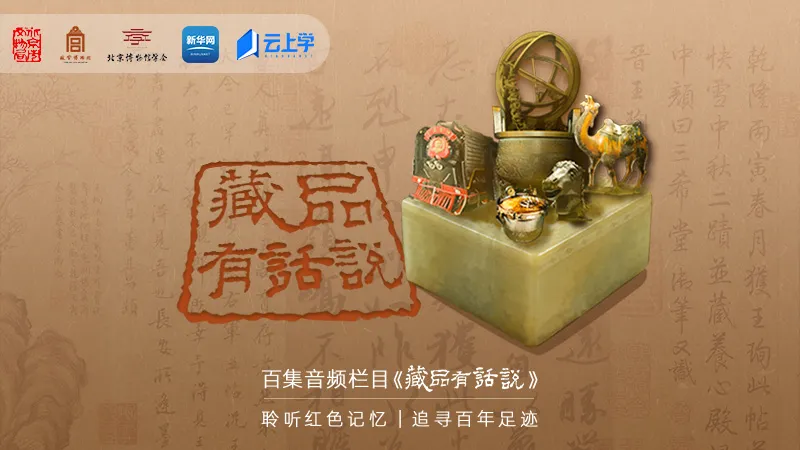Listen to red memories and follow in the footsteps of a century. The 100-episode audio column "Collection has Something to Say", jointly produced by the Beijing Municipal Bureau of Cultural Heritage, the Palace Museum, the Beijing Museum Society and the Xinhua network client, has been officially launched recently. The column selects more than 100 pieces of collections from nearly 60 museums, compiles collection stories and makes them into audio programs, and reviews the century-old struggle of the Communist Party of China and the Chinese nation by telling the stories of patriotic party and patriotic collections of museums, science and technology museums, art galleries and memorial halls in Beijing.

Episode 71 - BoYuan Thesis, not far away
Today, we invite Wang Siya from the Palace Museum to introduce you to a collection of cultural relics in the museum.
The Palace Museum now has a precious authentic manuscript of the Famous Eastern Jin Dynasty Artists, "Boyuan Ti", which was originally hidden in the Sanxi Hall of the Yangxin Hall, but was lost outside for some reason after 1924. What is the story of this? How did it return to the motherland? Today's "Collection has Something to Say" brings you the story of the Palace Museum's "Boyuan Ti".
The Palace Museum has a collection of more than 1.86 million cultural relics, some of which come from the old collection of the Qing Palace, some from the state allocation, and some of the collection was originally hidden in the palace, but it was lost for some reason and finally recovered.
"Boyuan Ti" is a letter greeting to a friend, just 5 lines and 47 words, expressing Wang Xun's concern about his friend's illness and the sorrow of the heavens. This post is natural and smooth, handsome and elegant, and is a model of the early days of the book.
In the eleventh year of Qianlong, the "Boyuan Thesis" was included in the Sanxi Hall of the Yangxin Hall, and along with it were two rare treasures, namely the "Qing Ti of the Fast Snow Time" by Wang Xizhi of the Book Saint and the "Mid-Autumn Festival" of his son Wang Xianzhi.
Of these three calligraphy works, the other two are facsimiles, except for the Boyuan Ti, which is the only handwritten manuscript, which is now recognized as the only authentic calligraphy of the famous artists of the Eastern Jin Dynasty, from which we can glimpse the supreme skill of the Calligraphy of the Langya Wang Clan 1,500 years ago, and its artistic and cultural relics are immeasurable.
The main hall of the Yangxin Hall is in the middle of the room
Qianlong Imperial Pen "SanxiTang" plaque
To this day, this heirloom treasure is still in the Palace Museum, and it has gone through many twists and turns behind it.
The gathering and dispersion of cultural relics has always been closely linked to the rise and fall of the national fortune, more than ten years after the Xinhai Revolution, "Boyuan Ti" and "Mid-Autumn Festival" were hidden together in the Shoukang Palace where the Jingyi Emperor's noble concubines lived, in 1924, when Puyi left the palace, the Jingyi Emperor's noble concubines secretly carried these two famous posters out of the palace, and then scattered, after several trips for the collector Guo Baochang.
After Guo Baochang's death, the two posters belonged to his son Guo Zhaojun. In 1949, Guo Zhaojun went to Hong Kong to do business with these two posts, and due to economic difficulties, he pledged the two posts to the bank for loans. According to the custom, if the loan is due and Guo Zhaojun is unable to return it, this rare treasure will be auctioned by the bank.
At that time, many foreign businessmen were eager to covet the treasure, and the national treasure was at risk of being lost overseas. Premier Zhou Enlai, who learned of the news, clearly instructed that the national treasure must be recovered.
Boyuan Thesis
There is also a letter in the Selected Letters of Zhou Enlai (November 5, 1951) involving two precious cultural relics, which states: "Agreeing to buy back Wang Xianzhi's Mid-Autumn Festival Thesis and Wang Xun's Boyuan Thesis, it is necessary to send responsible personnel and intellectuals to distinguish the authenticity, and must go through the reliable bank in Hong Kong now, Cha Ming, and whether the owner Guo Zhaojun has cheated or inflated the price to ensure the smooth purchase of the two posts..."
In the end, after many negotiations, the state resolutely chose to buy back two precious Fa Ti for 500,000 Hong Kong dollars.
Such a move clearly reflects the cpc's emphasis on the motherland's outstanding cultural heritage and the new China's policy of protecting cultural relics, and also reflects the attitude of the Chinese communists towards national culture, which has a far-reaching impact.
All along, the Communist Party of China attaches great importance to the cause of cultural construction, emphasizes the coordinated development of economic construction and cultural construction, and attaches importance to the protection and inheritance of outstanding national cultural heritage.
Since the founding of New China, countless treasures have returned to the motherland with the joint efforts of the party, the government and patriots from all walks of life, and over the years, the return of cultural relics has not only its own cultural relics and artistic value, but also the proof of the continuous vigorous development of the motherland.
Attaching great importance to cultural guidance and developing cultural undertakings, the ancient Chinese culture is radiating more vigorous vitality.
Palace museum
Founded in 1925, the Palace Museum is a large-scale comprehensive museum of ancient Chinese art established on the basis of the Ming and Qing Imperial Palaces and their collections. In 1961, the Forbidden City was listed by the State Council as the "First Batch of National Key Cultural Relics Protection Units", and in 1987 it was included in the "World Heritage List" by UNESCO.
Source: The Palace Museum, Beijing Museum Society, Xinhuanet client